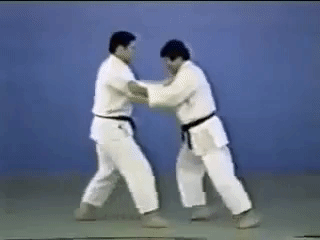This application is silly for a key reason: no one attacks like that with a stick. They would swing the stick down on you, in which case the way you "block" is useless.
Instead, one may interpret the movement as a throw. Because this set appears in two patterns (Choong-Moo and Sam-Il) I will provide two related applications.
Application 1: Funakoshi's "Cripple Wheel"
This is one of Funakoshi's classic "nine throws", some of which have been used in other taekwondo patterns. In this throw, use the U-shape block to scoop under the opponent's groin with the lower arm and reach around the front of their head with the upper arm. Spin while lifting the left leg and pulling the head to throw.
In Choong-Moo we may use the previous step, the 45-degree roundhouse kick, to knock back the opponent's right leg before throwing.
This throw has several variations. For example, you may execute it from under the opponent's left arm.
 |
| A wheel throw variant. Source for gif: Colin Wee (flipped horizontally to match form) |
Why the jump? It could be just for aesthetic reasons, or to represent lifting with your legs.
2nd Application: Fireman's carry followed by stomp
Another application usually offered is the fireman's carry or kata guruma. This is a throw that appears in Gen. Choi's Encyclopedia of Taekwon-Do, executed from a kneeling position.
In this throw, you grasp under the opponent's right leg (from inside) with your lower arm while grasping their right arm with your upper arm. Throw them over your shoulders.
Why use a spin in this case? You turn 90 to 180-degrees initially load the opponent onto your back and throw them. The remainder of the spin you perform with a jump so that you may stomp your downed opponent.
This is Iain Abernethy's preferred application for the set in Enpi. (Link shows application)
One argument in favor of teaching this for Choong-Moo is that the next set, which may be applied as a one-hand drop (kuckiki taoshi) is a classic Judo combination with kata guruma. If the opponent defends the fireman's carry by backing away from you, follow them forward and switch to the one-hand drop throw.
 |
| Switching from a fireman's carry to a one-hand drop |
The difference between the two applications provided is which leg you are attacking: the opponent's left leg in the case of the cripple wheel throw and their right leg in the case of the fireman's carry.
interesting, i had often been told that the jump was to indicate how deep you had to bend your knees and spring up from them to initiate a proper throw
ReplyDeleteYes, that was my impression of the jump as well. The stomp idea comes from Iain Abernethy.
DeleteVery helpful. Was practising this section this morning before work :-) when learning the form I usually try to shut off my application brain and just do the movements until I have the performance down, but I just couldn’t help wondering if there was anything out there that could explain this. Thanks for your good work. Best regards from Ørjan (Traditional TKD Ramblings).
ReplyDelete